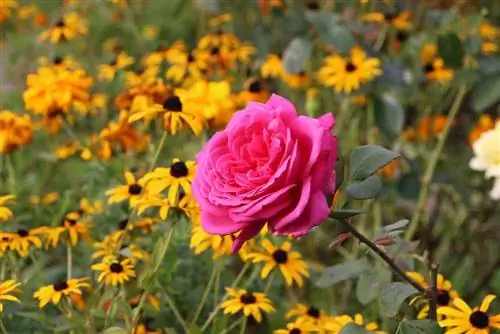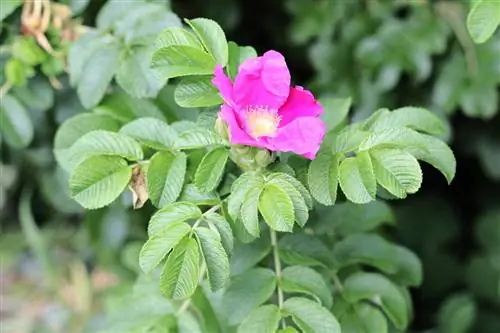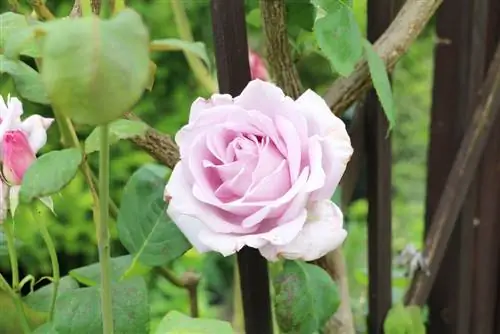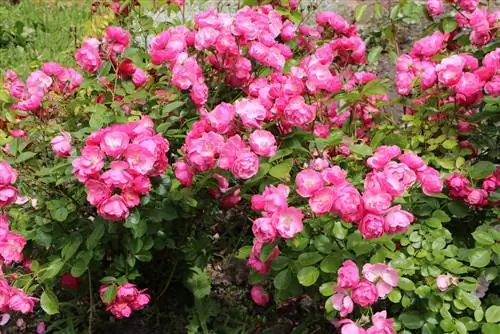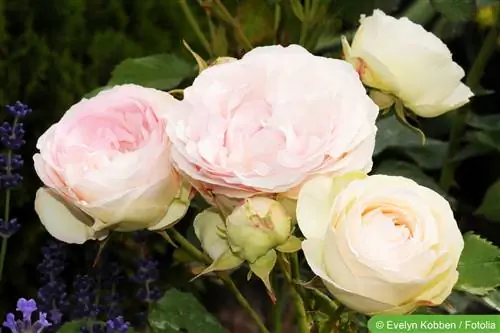- Author admin [email protected].
- Public 2023-12-17 03:39.
- Last modified 2025-01-24 12:45.
English roses are beautiful flowers, but they are also very demanding when it comes to care and cutting. If the care conditions are not right, growth will be inhibited and the plants will only produce poor flowers. Pruning in particular must be done correctly and at a fixed time of year, only then will the rose plants thrive. That's why you should definitely pay attention to the following tips.
Watering correctly
English roses develop deep roots and therefore do not need to be watered as often when it rains at normal intervals. However, there may be an increased need for watering during the hot and often very dry summer months. Rose plants do not tolerate water on their leaves and flowers, so be careful with the water when watering. If there is constant moisture on the leaves and flowers, this can quickly lead to fungal infestation.
- Water additionally during strong heat and longer dry periods
- Only water when the surface of the soil has dried out
- Keep plant substrate evenly moist
- Waterlogging must be avoided at all costs
- Give pouring units in the morning
- Water the soil with a water hose
- Allow water to completely soak into the soil
- Do not water over flowers and leaves
- Water young and not fully grown roses more often
Fertilize sufficiently
English roses have high demands when it comes to the supply of nutrients; these are essential for magnificent growth and abundant flowering. You can choose from elaborate rose fertilizers that are specifically tailored to the needs of the distinctive plants. There are both organic and mineral and organo-mineral fertilizers. However, fertilizer from specialist retailers should always be administered according to the manufacturer's instructions to avoid overdosing. If roses are over-fertilized, all parts of the plant become soft and the plant becomes significantly more susceptible to diseases and pests.
- The best time to fertilize is in March and June
- Use nitrogen-rich rose fertilizer
- Organic fertilizers protect the environment
- Ripe compost and cattle manure are ideal
- If there is a nutrient deficiency, use special organic-mineral fertilizer
- Fertilizers with a variety of nutrients are also suitable, including blue grain
- Apply potash in autumn, about 30 g per m²
- This sustainably strengthens winter hardiness
- Innovative rose fertilizers use fungal and bacterial cultures
- Administer fertilizer preparations when planting
- Provides additional stimulation of growth and flowering
Cut regularly
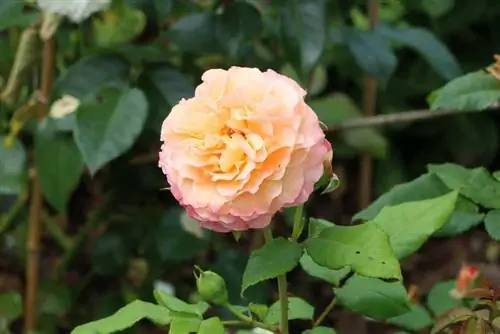
In order for English roses to sprout beautifully every year, they need regular pruning. Otherwise there will be poor growth and, in extreme cases, even no flowering. With this elementary care step, the life expectancy of the plants can be significantly extended, as well as their he alth maintained. Cutting is due both in summer and next spring. Normal pruning shears tend to crush the branches and shoots, which only causes the plant to suffer unnecessarily. Therefore, care should be taken to use high-quality cutting tools when cutting.
- Cut off old and faded flowers in summer
- Remove leaves and umbels too
- Remove old and dried shoots in spring
- Always use sharp and disinfected cutting tools
- Special rose scissors are ideal
- Place the cut 5 mm above a new bud
- Select outward-growing buds
- Remove all side shoots and also trim the branches
- Also stub caps
- When cutting, proceed at an angle
Good winter protection
English roses are usually hardy enough to overwinter in these latitudes without any problems. However, extreme altitudes and exposed locations can cause problems in winter. It is therefore advisable to take some preparatory protective measures to ensure that the plants do not suffer damage due to the cold winter temperatures. Although rose plants can tolerate temperatures below zero, they are very sensitive when there are extreme fluctuations between cold and warm temperatures. This change from freezing to thawing of the plant cells weakens the roses in the long term and wears them out enormously.
- Cover root neck as a protective measure
- Heaped compost or leaves are ideal for this
- Cover the floor with reed mats to keep out frost and snow
- Cover ground-covering roses completely with brushwood, straw or pine branches
- For tall varieties, attach warming protection made of fabric fleece or jute
- Additionally cover fresh processing areas
- Attach and remove winter protection depending on the weather
- In cold and long winters, only remove again at the end of March or beginning of April
Apply a layer of mulch
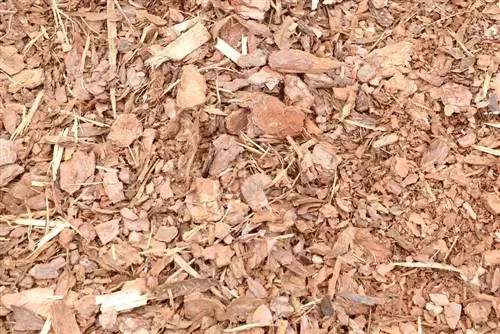
It is highly recommended to mulch the English roses. In this way, soil moisture can be retained for longer and weed growth can be suppressed. Mulching can be done all year round and is particularly effective before the summer months. The thicker the layer of mulch is applied, the slower the soil loses moisture. In addition, even fewer weeds settle in this case. If the soil is extremely dry before mulching, then it should be watered thoroughly either before or after.
- Mulch early, around March
- Ideally use fine bark mulch
- First remove all weeds in the rose bed
- Then apply an approximately 3 cm thick layer of bark mulch
- Spread a generous layer of mulch around the roses
- Also apply to the adjacent areas of soil
Removing faded flowers
In addition to periodic pruning, the English roses should be cleaned out regularly. This can stimulate new bursts of flowers and sustainably extend the flowering period. Additionally, preening prevents seeds from developing in the rose hips after flowering is over. In this way, the rose plants have more strength for the subsequent bursts of flowers. In addition, the growth habit can be determined and maintained so that the roses grow in a beautiful shape. When the plants prepare for winter rest, they slowly stop producing flowers and growth pauses. Then cleaning should be postponed until next year.
- Clean out immediately after each flowering phase
- Proceed in this way from spring to the end of September
- Short each flower shoot down to three leaflets
- The extent of cleaning determines the shape and size of the roses
- If you are unsure, apply scissors to the shoot where flowers no longer grow
Prevent soil fatigue
Rosaceae in particular are severely affected by soil fatigue. If roses are repeatedly planted in the garden bed at the same location, then the young generation of plants will show poor growth. The leaves, flowers and roots do not develop properly, so the roses die relatively young. The causes of soil fatigue are not completely known, but there are significant procedures that can be used to protect the noble flowers from this undesirable damage.
- Do not plant English roses repeatedly in the same location
- Relocate existing plants immediately if there are signs of initial damage
- Then apply rich fertilizer to the tired garden bed
- Incorporate seaweed lime and well-ripened compost into the soil
- If there are no location options, completely replace the soil
Enrich soil
English roses are deep-rooted, so the downward path of the roots must be clear. Often the ground is blocked by compacted soil and does not provide room for rose roots to grow. It should be noted that after a few years the rootstock can develop to a considerable length of between one and two meters. In addition, it sinks relatively quickly into the ground. If the roots can grow freely, this also promotes above-ground growth.
- Deep and loose soil is ideal
- Pay attention to sandy-loamy areas with lots of humus
- Using special rose soil is ideal
- Permeable properties prevent waterlogging in the long term
- Loosen compacted soil and dig deeply
- Enrich nutrient-poor soil or even replace it completely
- Make sure the pH value is neutral, values between 6.5 and 7.5 are perfect
Watch out for diseases and pests
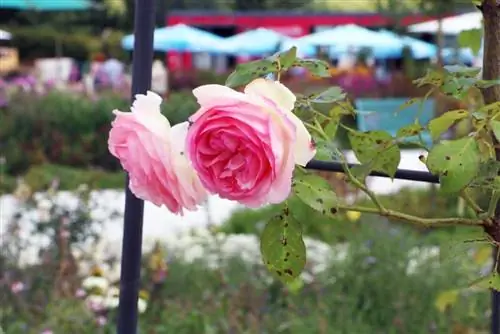
The English roses are not only demanding to care for, but are also susceptible to various diseases and pests. An infestation often occurs due to errors in care or incorrect location conditions. It is therefore important to regularly check the plants in order to be able to react immediately when diseases and pests first appear. Prolonged drought weakens the immune system of rose plants, making them more susceptible to disease. That's why the soil should never dry out completely, but it shouldn't be too wet either.
- Mildew appears quickly on dry leaves
- Fungal infestation develops on permanently wet leaves and flowers
- Cut off affected shoot tips to prevent spread
- Aphid infestations are common
- Wash carefully with soapy water
- Use nettle manure for spraying
- Rose leaf wasp likes to eat rose petals
- Collect their larvae directly
- In extreme cases, spray with insecticide from specialist retailers
- Do the same thing with the rose shoot borer
Strengthen the immune system
In order to support the very vulnerable English roses, they should receive additional treatment to strengthen their immune system. In this way, the plants become more resistant to diseases and pests.
- Dust or sprinkle with rock dust
- Apply treatment from bud break
- Inject with horsetail broth when the first leaves appear

